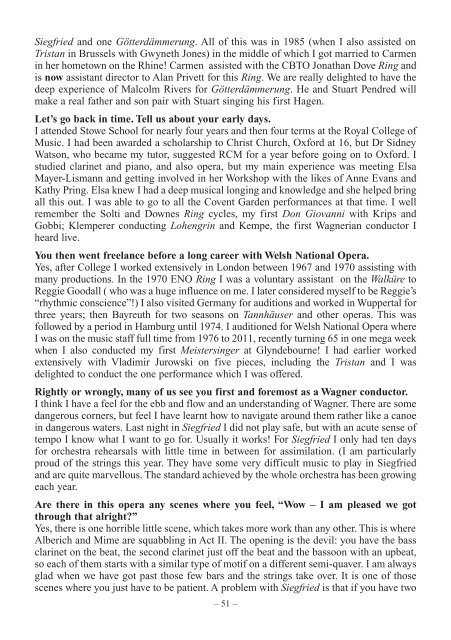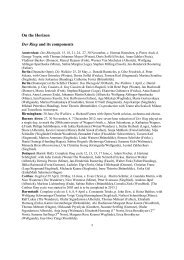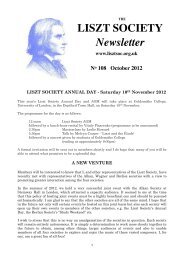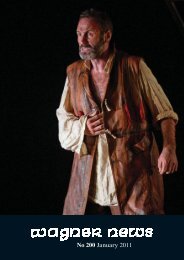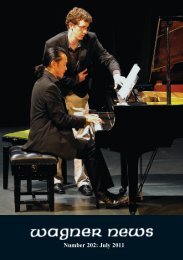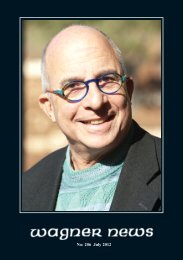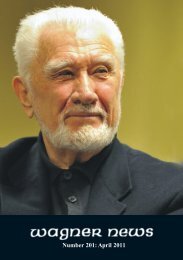13895 Wagner News 174 - Wagner Society of England
13895 Wagner News 174 - Wagner Society of England
13895 Wagner News 174 - Wagner Society of England
You also want an ePaper? Increase the reach of your titles
YUMPU automatically turns print PDFs into web optimized ePapers that Google loves.
Siegfried and one Götterdämmerung. All <strong>of</strong> this was in 1985 (when I also assisted on<br />
Tristan in Brussels with Gwyneth Jones) in the middle <strong>of</strong> which I got married to Carmen<br />
in her hometown on the Rhine! Carmen assisted with the CBTO Jonathan Dove Ring and<br />
is now assistant director to Alan Privett for this Ring. We are really delighted to have the<br />
deep experience <strong>of</strong> Malcolm Rivers for Götterdämmerung. He and Stuart Pendred will<br />
make a real father and son pair with Stuart singing his first Hagen.<br />
Let’s go back in time. Tell us about your early days.<br />
I attended Stowe School for nearly four years and then four terms at the Royal College <strong>of</strong><br />
Music. I had been awarded a scholarship to Christ Church, Oxford at 16, but Dr Sidney<br />
Watson, who became my tutor, suggested RCM for a year before going on to Oxford. I<br />
studied clarinet and piano, and also opera, but my main experience was meeting Elsa<br />
Mayer-Lismann and getting involved in her Workshop with the likes <strong>of</strong> Anne Evans and<br />
Kathy Pring. Elsa knew I had a deep musical longing and knowledge and she helped bring<br />
all this out. I was able to go to all the Covent Garden performances at that time. I well<br />
remember the Solti and Downes Ring cycles, my first Don Giovanni with Krips and<br />
Gobbi; Klemperer conducting Lohengrin and Kempe, the first <strong>Wagner</strong>ian conductor I<br />
heard live.<br />
You then went freelance before a long career with Welsh National Opera.<br />
Yes, after College I worked extensively in London between 1967 and 1970 assisting with<br />
many productions. In the 1970 ENO Ring I was a voluntary assistant on the Walküre to<br />
Reggie Goodall ( who was a huge influence on me. I later considered myself to be Reggie’s<br />
“rhythmic conscience”!) I also visited Germany for auditions and worked in Wuppertal for<br />
three years; then Bayreuth for two seasons on Tannhäuser and other operas. This was<br />
followed by a period in Hamburg until 1974. I auditioned for Welsh National Opera where<br />
I was on the music staff full time from 1976 to 2011, recently turning 65 in one mega week<br />
when I also conducted my first Meistersinger at Glyndebourne! I had earlier worked<br />
extensively with Vladimir Jurowski on five pieces, including the Tristan and I was<br />
delighted to conduct the one performance which I was <strong>of</strong>fered.<br />
Rightly or wrongly, many <strong>of</strong> us see you first and foremost as a <strong>Wagner</strong> conductor.<br />
I think I have a feel for the ebb and flow and an understanding <strong>of</strong> <strong>Wagner</strong>. There are some<br />
dangerous corners, but feel I have learnt how to navigate around them rather like a canoe<br />
in dangerous waters. Last night in Siegfried I did not play safe, but with an acute sense <strong>of</strong><br />
tempo I know what I want to go for. Usually it works! For Siegfried I only had ten days<br />
for orchestra rehearsals with little time in between for assimilation. (I am particularly<br />
proud <strong>of</strong> the strings this year. They have some very difficult music to play in Siegfried<br />
and are quite marvellous. The standard achieved by the whole orchestra has been growing<br />
each year.<br />
Are there in this opera any scenes where you feel, “Wow – I am pleased we got<br />
through that alright?”<br />
Yes, there is one horrible little scene, which takes more work than any other. This is where<br />
Alberich and Mime are squabbling in Act II. The opening is the devil: you have the bass<br />
clarinet on the beat, the second clarinet just <strong>of</strong>f the beat and the bassoon with an upbeat,<br />
so each <strong>of</strong> them starts with a similar type <strong>of</strong> motif on a different semi-quaver. I am always<br />
glad when we have got past those few bars and the strings take over. It is one <strong>of</strong> those<br />
scenes where you just have to be patient. A problem with Siegfried is that if you have two<br />
– 51 –


